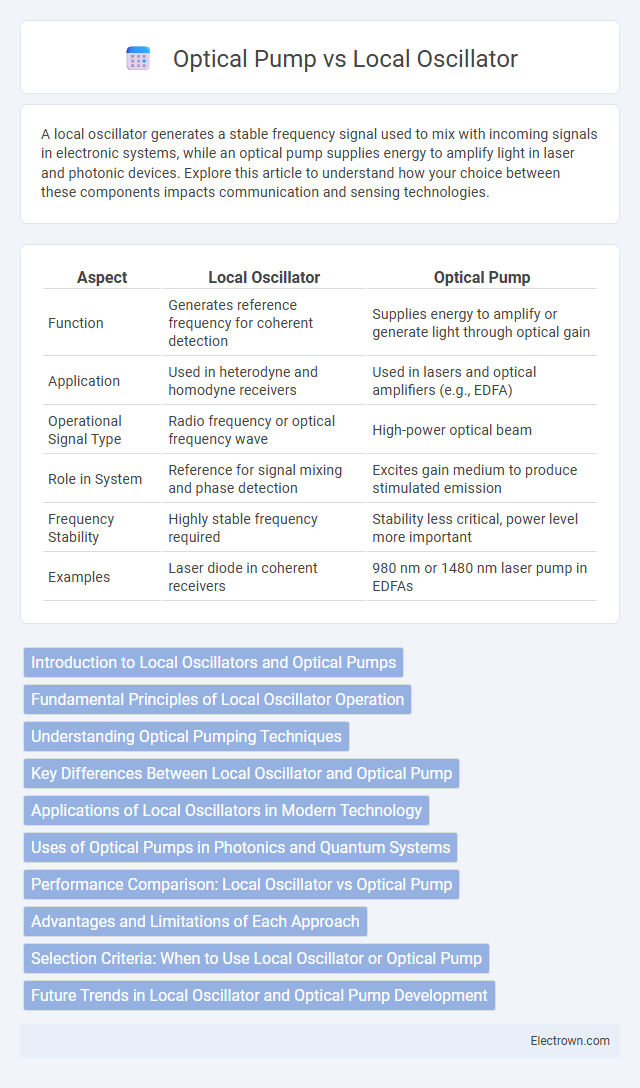A local oscillator generates a stable frequency signal used to mix with incoming signals in electronic systems, while an optical pump supplies energy to amplify light in laser and photonic devices. Explore this article to understand how your choice between these components impacts communication and sensing technologies.
Table of Comparison
| Aspect | Local Oscillator | Optical Pump |
|---|---|---|
| Function | Generates reference frequency for coherent detection | Supplies energy to amplify or generate light through optical gain |
| Application | Used in heterodyne and homodyne receivers | Used in lasers and optical amplifiers (e.g., EDFA) |
| Operational Signal Type | Radio frequency or optical frequency wave | High-power optical beam |
| Role in System | Reference for signal mixing and phase detection | Excites gain medium to produce stimulated emission |
| Frequency Stability | Highly stable frequency required | Stability less critical, power level more important |
| Examples | Laser diode in coherent receivers | 980 nm or 1480 nm laser pump in EDFAs |
Introduction to Local Oscillators and Optical Pumps
Local oscillators serve as stable reference frequency sources in coherent optical communication systems, enabling precise signal mixing and detection. Optical pumps provide the necessary energy to amplify signals through nonlinear processes such as four-wave mixing or Raman amplification in fiber optics. Both components play essential roles in enhancing signal quality and system performance in advanced photonic technologies.
Fundamental Principles of Local Oscillator Operation
A local oscillator (LO) generates a stable frequency signal used in heterodyne detection to mix with an incoming optical signal, enabling frequency down-conversion and precise signal extraction. Operating on principles of frequency stability and phase coherence, the LO maintains a fixed frequency that matches or closely approximates the carrier frequency of the optical signal for efficient signal demodulation. Unlike optical pumps that provide energy for nonlinear optical processes, local oscillators are crucial for enabling accurate signal amplification and detection in optical communication systems.
Understanding Optical Pumping Techniques
Optical pumping techniques utilize an optical pump to excite electrons in a medium, creating population inversion essential for laser operation, while a local oscillator typically provides a reference frequency in coherent detection systems. Optical pumps use specific wavelengths of light to manipulate atomic or molecular states, enhancing laser efficiency and enabling precise control of emission properties. This contrasts with local oscillators, which primarily serve signal processing functions rather than directly influencing the energy states of the lasing medium.
Key Differences Between Local Oscillator and Optical Pump
Local oscillators generate stable radio frequency or microwave signals primarily used for frequency conversion in heterodyne detection systems, while optical pumps supply coherent light energy to drive nonlinear optical processes such as amplification or frequency conversion. Unlike optical pumps that operate typically in the visible or near-infrared spectrum for laser excitation, local oscillators function in electronic frequency domains and play crucial roles in signal mixing and phase-sensitive detection. The fundamental difference lies in their operational domains and applications: local oscillators aid in signal processing and detection, whereas optical pumps provide the necessary energy input to induce nonlinear optical phenomena.
Applications of Local Oscillators in Modern Technology
Local oscillators are integral in modern communication systems, enabling precise frequency generation for signal modulation and demodulation. Their applications extend to radar systems, where they support target detection by providing stable carrier frequencies. You rely on local oscillators for critical functions in wireless networks, satellite communications, and frequency synthesis in electronic devices.
Uses of Optical Pumps in Photonics and Quantum Systems
Optical pumps are essential in photonics and quantum systems for stimulating electron transitions, enabling laser action, and facilitating amplification in optical fibers and waveguides. They provide coherent energy input necessary for processes like stimulated emission in lasers, quantum state manipulation in qubits, and enhancing signal strength in nonlinear optical devices. Unlike local oscillators that mix frequencies for detection, optical pumps directly drive energy transitions to control light-matter interactions at the quantum and photonic levels.
Performance Comparison: Local Oscillator vs Optical Pump
The local oscillator provides high phase stability and precise frequency control essential for coherent detection, enabling improved signal-to-noise ratio in optical communication systems. Optical pumps, used in amplification processes like Raman or parametric amplification, deliver high gain but may introduce noise and spectral broadening, affecting system performance. Your choice depends on whether phase accuracy or amplification strength is prioritized, as local oscillators excel in coherent detection while optical pumps enhance signal power.
Advantages and Limitations of Each Approach
Local oscillators offer high phase stability and precise frequency control, making them ideal for coherent detection in optical communication systems. Optical pumps enable efficient signal amplification through nonlinear interactions but require complex setups and careful power management to prevent signal distortion. Your choice depends on the need for stability versus amplification efficiency, balancing system complexity and performance requirements.
Selection Criteria: When to Use Local Oscillator or Optical Pump
Selection criteria between a local oscillator and an optical pump depend on your application's requirements for coherence, wavelength stability, and signal amplification. Local oscillators are ideal for heterodyne detection systems needing precise frequency control and phase stability, while optical pumps excel in nonlinear optics or fiber amplification where high power and gain are essential. Choosing the appropriate source ensures optimal system performance by matching coherence properties and power levels to your specific optical signal processing needs.
Future Trends in Local Oscillator and Optical Pump Development
Future trends in local oscillator development emphasize improving phase noise reduction and integrating ultra-stable frequency sources for enhanced signal coherence in advanced communication systems. Optical pump technology is advancing toward higher power efficiency and tunability to support next-generation photonic devices and nonlinear optical applications. Both fields are converging with innovations in integrated photonics and quantum technologies to achieve greater miniaturization and performance stability.
local oscillator vs optical pump Infographic

 electrown.com
electrown.com